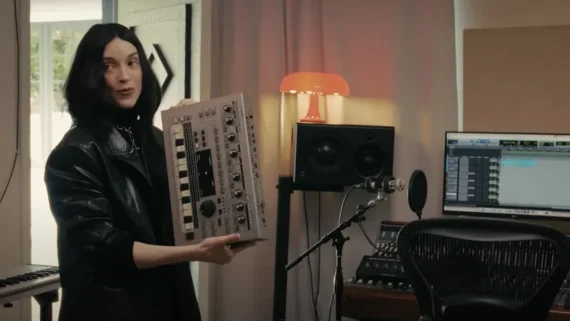VProm 3 Emulates + Expands On Vintage EPROM-Based Drum Machines

Aly James Lab has introduced VProm 3.0, a major update to their virtual instrument for Windows & Mac
VProm is a virtual instrument that emulates the EPROM-based drum machines of the 80s, primarily the LM-1. In addition, it lets you create and load custom EPROM sound files.
VProm 3.0 video intro:
New in VProm 3.0:
- Enhanced circuit emulation:
- Enhanced circuit emulation, including some OB DMX voice cards features like VCA and filter tracking, customizable start and end memory points and loop control.
- Upgraded voltage-controlled CEM filters with expanded controls—adjust trimmer, decay, pulse time, envelope response, or keep it simple with legacy mode (just one pulse control).
- µLaw madness
- Real-time variable sample rate decoding of EPROM sound data using the precise AM6070 DAC response, ensuring unparalleled authenticity.
- New unique µLaw DAC real-time transfer response customization per voice—allowing precise control over the µLaw decompression ratio. By tweaking the transfer function slightly, you can subtly refine the response to better approximate real-world variations between original AM6070 DAC chips. At extreme settings, this feature transforms into a unique powerful creative transient / distortion shaper: with ratios closer to 0.5/1, quieter details are brought forward significantly, while values above 1/1 enhance snappiness and impact, delivering a uniquely dynamic and tonal character, a unique feature taking advantage of digital processing while keeping some level of authenticity.
- Sample/Convert/Burn
- VProm now features a built-in EPROM creator, allowing you to generate custom EPROM binary files without any external tools and ready for use in VPROM or hardware drum machines.
- Import any .wav file and sample it just like in the classic hardware days. The resampling process uses a crude emulated R2R ADC with tweakable input settings and home-made tweaks* before capturing at ? 27 kHz. If the original .wav file rate is less or equal than 27 kHz, resampling is bypassed. You can also disable the resampling stage if needed.
- Once sampled, preview the file with µLaw 8bit (12bit quality) compression applied or save it directly as a µLaw-encoded .bin EPROM file.
- Maximum EPROM size is 64K ? 2.5 seconds @ 27Khz —larger sampled .wav files will be automatically truncated to fit during sampling.
- Make your own:
- New EPROM Management Panel – Manage all 14 custom EPROMs in one window with **waveform visualization**, direct loading on click, real-time auditioning, quick reset, and more.
- New EPROM Library Browser – Easily access, preview, and organize your custom and vintage EPROMs from a dedicated internal library.
- New .VPromKit Format – Save and reload an entire custom EPROM set as a .VPromKit file, allowing you to switch drum kits instantly without affecting other settings.
- That ‘Mythical Feel’:
- Authentic 48 PPQN Timing Emulation – Recreates the subtle groove and feel of vintage drum machines. Unlike modern high-resolution clocks (~960 PPQN), this low-res 48 PPQN pulse locks trigger events in real-time, syncing tightly to your DAW. The effect is subtle but noticeable, especially on swung or loose beats, adding that extra bit of human feel without overhyping the impact.
- Real-Time Clock Drift – Recreates the natural clock drift found in vintage drum machines, where internal clocks were never perfectly stable. Unlike the subtle effect of the 48 PPQN clock, this feature introduces a more noticeable, organic timing shift, mimicking the imperfections of classic hardware. With a tweakable drift range from 1ms to 40ms, you can achieve anything from a realistic analog-style drift to a more exaggerated laid-back groove, similar to a drummer playing with extreme looseness and feel.
VProm Audio Demos:
VProm 3.0 is available now for €56.



